tire type CADILLAC ESCALADE 2010 3.G Owners Manual
[x] Cancel search | Manufacturer: CADILLAC, Model Year: 2010, Model line: ESCALADE, Model: CADILLAC ESCALADE 2010 3.GPages: 616, PDF Size: 39.41 MB
Page 402 of 616
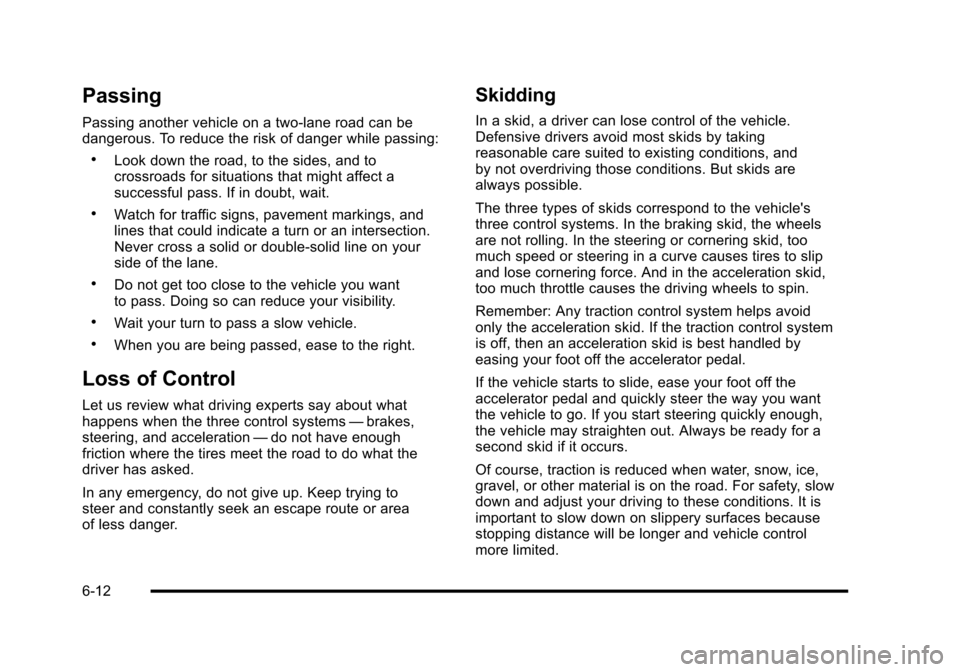
Passing
Passing another vehicle on a two-lane road can bedangerous. To reduce the risk of danger while passing:
.Look down the road, to the sides, and tocrossroads for situations that might affect asuccessful pass. If in doubt, wait.
.Watch for traffic signs, pavement markings, andlines that could indicate a turn or an intersection.Never cross a solid or double!solid line on yourside of the lane.
.Do not get too close to the vehicle you wantto pass. Doing so can reduce your visibility.
.Wait your turn to pass a slow vehicle.
.When you are being passed, ease to the right.
Loss of Control
Let us review what driving experts say about whathappens when the three control systems—brakes,steering, and acceleration—do not have enoughfriction where the tires meet the road to do what thedriver has asked.
In any emergency, do not give up. Keep trying tosteer and constantly seek an escape route or areaof less danger.
Skidding
In a skid, a driver can lose control of the vehicle.Defensive drivers avoid most skids by takingreasonable care suited to existing conditions, andby not overdriving those conditions. But skids arealways possible.
The three types of skids correspond to the vehicle'sthree control systems. In the braking skid, the wheelsare not rolling. In the steering or cornering skid, toomuch speed or steering in a curve causes tires to slipand lose cornering force. And in the acceleration skid,too much throttle causes the driving wheels to spin.
Remember: Any traction control system helps avoidonly the acceleration skid. If the traction control systemis off, then an acceleration skid is best handled byeasing your foot off the accelerator pedal.
If the vehicle starts to slide, ease your foot off theaccelerator pedal and quickly steer the way you wantthe vehicle to go. If you start steering quickly enough,the vehicle may straighten out. Always be ready for asecond skid if it occurs.
Of course, traction is reduced when water, snow, ice,gravel, or other material is on the road. For safety, slowdown and adjust your driving to these conditions. It isimportant to slow down on slippery surfaces becausestopping distance will be longer and vehicle controlmore limited.
6-12
Page 415 of 616
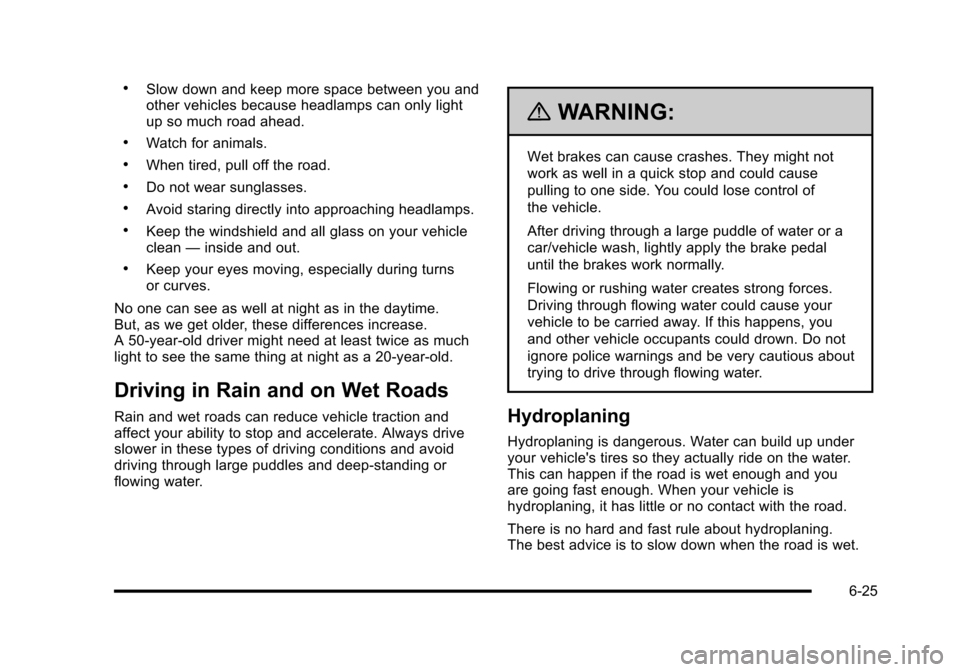
.Slow down and keep more space between you andother vehicles because headlamps can only lightup so much road ahead.
.Watch for animals.
.When tired, pull off the road.
.Do not wear sunglasses.
.Avoid staring directly into approaching headlamps.
.Keep the windshield and all glass on your vehicleclean—inside and out.
.Keep your eyes moving, especially during turnsor curves.
No one can see as well at night as in the daytime.But, as we get older, these differences increase.A 50-year-old driver might need at least twice as muchlight to see the same thing at night as a 20-year-old.
Driving in Rain and on Wet Roads
Rain and wet roads can reduce vehicle traction andaffect your ability to stop and accelerate. Always driveslower in these types of driving conditions and avoiddriving through large puddles and deep!standing orflowing water.
{WARNING:
Wet brakes can cause crashes. They might not
work as well in a quick stop and could cause
pulling to one side. You could lose control of
the vehicle.
After driving through a large puddle of water or a
car/vehicle wash, lightly apply the brake pedal
until the brakes work normally.
Flowing or rushing water creates strong forces.
Driving through flowing water could cause your
vehicle to be carried away. If this happens, you
and other vehicle occupants could drown. Do not
ignore police warnings and be very cautious about
trying to drive through flowing water.
Hydroplaning
Hydroplaning is dangerous. Water can build up underyour vehicle's tires so they actually ride on the water.This can happen if the road is wet enough and youare going fast enough. When your vehicle ishydroplaning, it has little or no contact with the road.
There is no hard and fast rule about hydroplaning.The best advice is to slow down when the road is wet.
6-25
Page 436 of 616

Trailering may be limited by the vehicle's ability tocarry tongue weight. Tongue or kingpin weight cannotcause the vehicle to exceed the GVWR (Gross VehicleWeight Rating) or the RGAWR (Rear Gross Axle WeightRating). See“Total Weight on the Vehicle's Tires”laterin this section for more information.
After loading the trailer, weigh the trailer and then thetongue, separately, to see if the weights are proper.If they are not, adjustments might be made by movingsome items around in the trailer.
Total Weight on the Vehicle's Tires
Be sure the vehicle's tires are inflated to the inflationpressures found on the Certification label on the driverdoor or seeLoading the Vehicleon page 6!32for moreinformation. Make sure not to exceed the GVWR limitfor the vehicle, or the RGAWR, with the tow vehicle andtrailer fully loaded for the trip including the weight of thetrailer tongue. If using a weight distributing hitch, makesure not to exceed the RGAWR before applying theweight distribution spring bars.
Weight of the Trailering Combination
It is important that the combination of the towvehicle and trailer does not exceed any of its weightratings—GCWR, GVWR, RGAWR, Trailer WeightRating or Tongue Weight. The only way to be sure it isnot exceeding any of these ratings is to weigh the towvehicle and trailer combination, fully loaded for the trip,getting individual weights for each of these items.
Hitches
The correct hitch equipment helps maintain combinationcontrol. Most small-to-medium trailers can be towedwith a weight carrying hitch which simply features acoupler latched to the hitch ball. Larger trailers mayrequire a weight distributing hitch that uses spring barsto distribute the trailer tongue weight among thetwo vehicle and trailer axles. See“Weight of the TrailerTongue”earlier in this section for rating limits withvarious hitch types.
If a step-bumper hitch will be used, the bumper couldbe damaged in sharp turns. Make sure there is ampleroom when turning to avoid contact between the trailerand the bumper.
Consider using sway controls with any trailer. Ask atrailering professional about sway controls or refer tothe trailer manufacturer's recommendations andinstructions.
6-46
Page 506 of 616
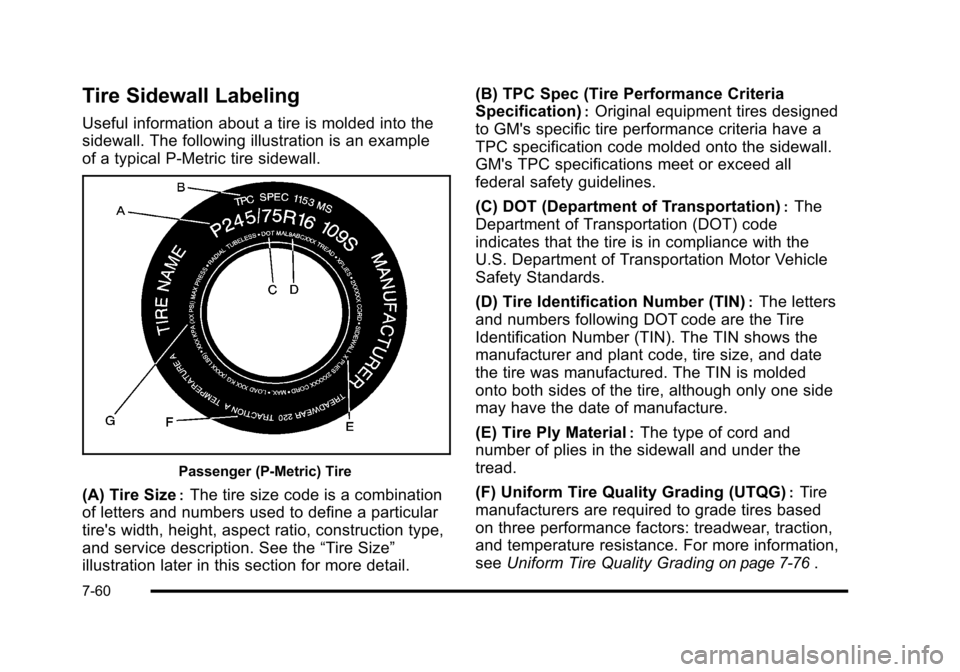
Tire Sidewall Labeling
Useful information about a tire is molded into the
sidewall. The following illustration is an example
of a typical P!Metric tire sidewall.
Passenger (P!Metric) Tire
(A) Tire Size:The tire size code is a combination
of letters and numbers used to define a particular
tire's width, height, aspect ratio, construction type,
and service description. See the“Tire Size”
illustration later in this section for more detail.
(B) TPC Spec (Tire Performance Criteria
Specification):Original equipment tires designed
to GM's specific tire performance criteria have a
TPC specification code molded onto the sidewall.
GM's TPC specifications meet or exceed all
federal safety guidelines.
(C) DOT (Department of Transportation):The
Department of Transportation (DOT) code
indicates that the tire is in compliance with the
U.S. Department of Transportation Motor Vehicle
Safety Standards.
(D) Tire Identification Number (TIN):The letters
and numbers following DOT code are the Tire
Identification Number (TIN). The TIN shows the
manufacturer and plant code, tire size, and date
the tire was manufactured. The TIN is molded
onto both sides of the tire, although only one side
may have the date of manufacture.
(E) Tire Ply Material:The type of cord and
number of plies in the sidewall and under the
tread.
(F) Uniform Tire Quality Grading (UTQG):Tire
manufacturers are required to grade tires based
on three performance factors: treadwear, traction,
and temperature resistance. For more information,
seeUniform Tire Quality Gradingon page 7!76.
7-60
Page 507 of 616
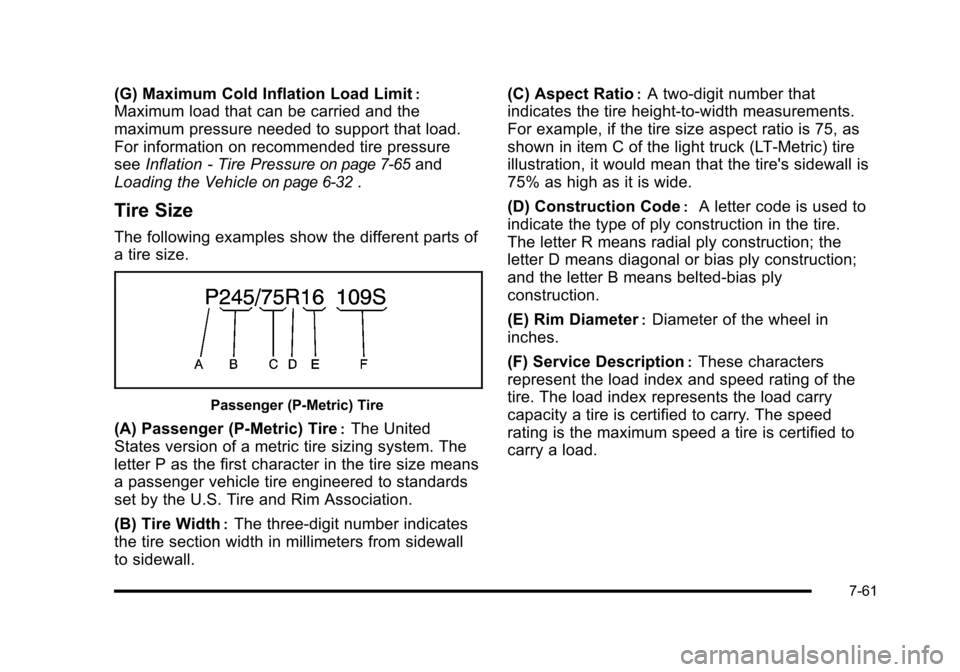
(G) Maximum Cold Inflation Load Limit:
Maximum load that can be carried and the
maximum pressure needed to support that load.
For information on recommended tire pressure
seeInflation - Tire Pressureon page 7!65and
Loading the Vehicleon page 6!32.
Tire Size
The following examples show the different parts of
a tire size.
Passenger (P!Metric) Tire
(A) Passenger (P!Metric) Tire:The United
States version of a metric tire sizing system. The
letter P as the first character in the tire size means
a passenger vehicle tire engineered to standards
set by the U.S. Tire and Rim Association.
(B) Tire Width:The three!digit number indicates
the tire section width in millimeters from sidewall
to sidewall.
(C) Aspect Ratio:A two!digit number that
indicates the tire height!to!width measurements.
For example, if the tire size aspect ratio is 75, as
shown in item C of the light truck (LT!Metric) tire
illustration, it would mean that the tire's sidewall is
75% as high as it is wide.
(D) Construction Code:A letter code is used to
indicate the type of ply construction in the tire.
The letter R means radial ply construction; the
letter D means diagonal or bias ply construction;
and the letter B means belted!bias ply
construction.
(E) Rim Diameter:Diameter of the wheel in
inches.
(F) Service Description:These characters
represent the load index and speed rating of the
tire. The load index represents the load carry
capacity a tire is certified to carry. The speed
rating is the maximum speed a tire is certified to
carry a load.
7-61
Page 512 of 616
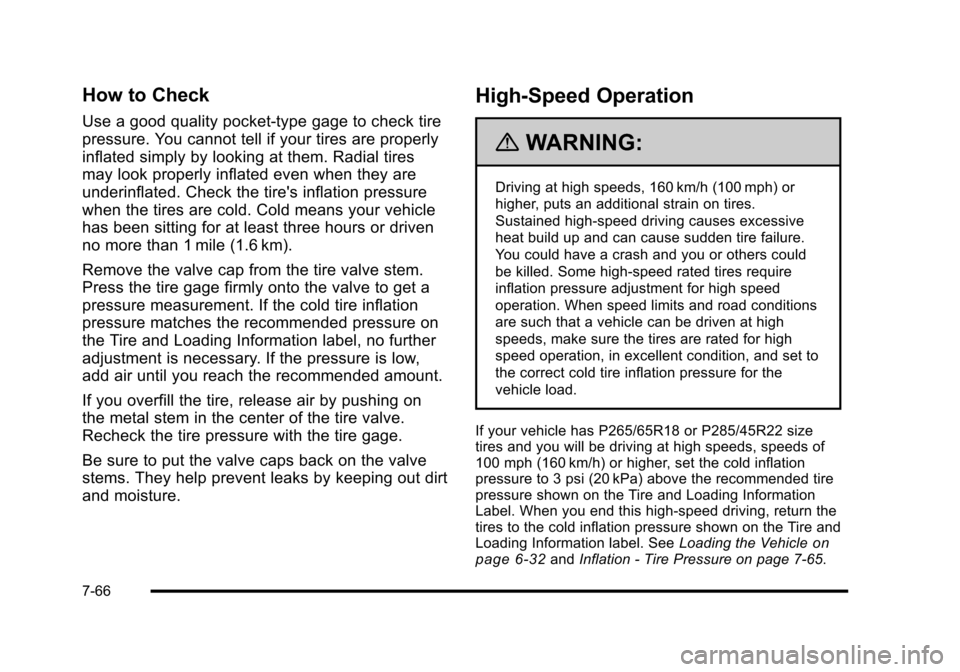
How to Check
Use a good quality pocket-type gage to check tire
pressure. You cannot tell if your tires are properly
inflated simply by looking at them. Radial tires
may look properly inflated even when they are
underinflated. Check the tire's inflation pressure
when the tires are cold. Cold means your vehicle
has been sitting for at least three hours or driven
no more than 1 mile (1.6 km).
Remove the valve cap from the tire valve stem.
Press the tire gage firmly onto the valve to get a
pressure measurement. If the cold tire inflation
pressure matches the recommended pressure on
the Tire and Loading Information label, no further
adjustment is necessary. If the pressure is low,
add air until you reach the recommended amount.
If you overfill the tire, release air by pushing on
the metal stem in the center of the tire valve.
Recheck the tire pressure with the tire gage.
Be sure to put the valve caps back on the valve
stems. They help prevent leaks by keeping out dirt
and moisture.
High-Speed Operation
{WARNING:
Driving at high speeds, 160 km/h (100 mph) or
higher, puts an additional strain on tires.
Sustained high-speed driving causes excessive
heat build up and can cause sudden tire failure.
You could have a crash and you or others could
be killed. Some high-speed rated tires require
inflation pressure adjustment for high speed
operation. When speed limits and road conditions
are such that a vehicle can be driven at high
speeds, make sure the tires are rated for high
speed operation, in excellent condition, and set to
the correct cold tire inflation pressure for the
vehicle load.
If your vehicle has P265/65R18 or P285/45R22 sizetires and you will be driving at high speeds, speeds of100 mph (160 km/h) or higher, set the cold inflationpressure to 3 psi (20 kPa) above the recommended tirepressure shown on the Tire and Loading InformationLabel. When you end this high!speed driving, return thetires to the cold inflation pressure shown on the Tire andLoading Information label. SeeLoading the Vehicleonpage 6!32andInflation - Tire Pressure on page 7!65.
7-66
Page 520 of 616
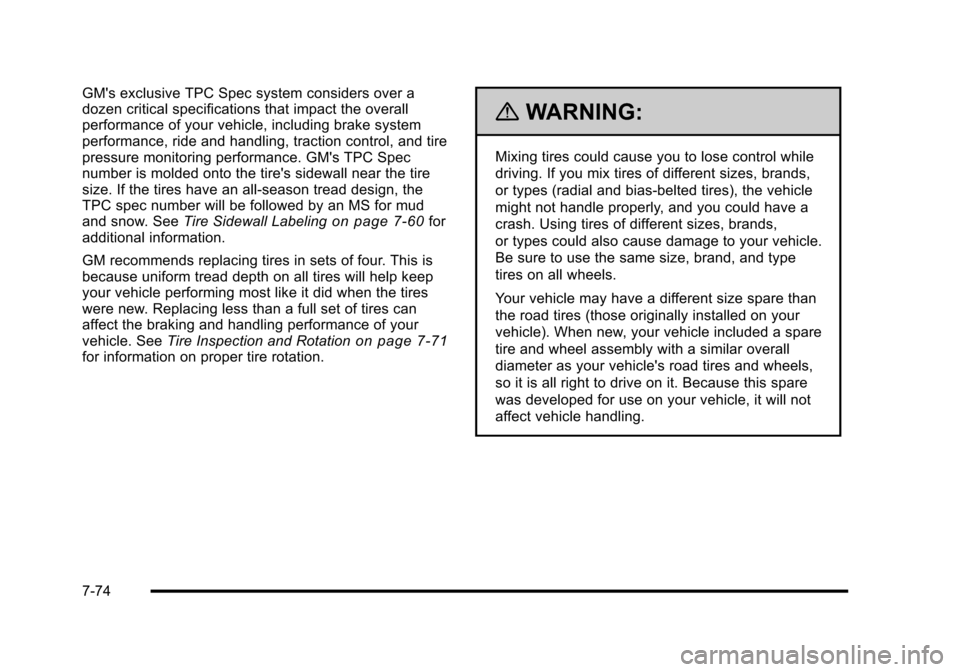
GM's exclusive TPC Spec system considers over adozen critical specifications that impact the overallperformance of your vehicle, including brake systemperformance, ride and handling, traction control, and tirepressure monitoring performance. GM's TPC Specnumber is molded onto the tire's sidewall near the tiresize. If the tires have an all!season tread design, theTPC spec number will be followed by an MS for mudand snow. SeeTire Sidewall Labelingon page 7!60foradditional information.
GM recommends replacing tires in sets of four. This isbecause uniform tread depth on all tires will help keepyour vehicle performing most like it did when the tireswere new. Replacing less than a full set of tires canaffect the braking and handling performance of yourvehicle. SeeTire Inspection and Rotationon page 7!71for information on proper tire rotation.
{WARNING:
Mixing tires could cause you to lose control while
driving. If you mix tires of different sizes, brands,
or types (radial and bias-belted tires), the vehicle
might not handle properly, and you could have a
crash. Using tires of different sizes, brands,
or types could also cause damage to your vehicle.
Be sure to use the same size, brand, and type
tires on all wheels.
Your vehicle may have a different size spare than
the road tires (those originally installed on your
vehicle). When new, your vehicle included a spare
tire and wheel assembly with a similar overall
diameter as your vehicle's road tires and wheels,
so it is all right to drive on it. Because this spare
was developed for use on your vehicle, it will not
affect vehicle handling.
7-74
Page 521 of 616
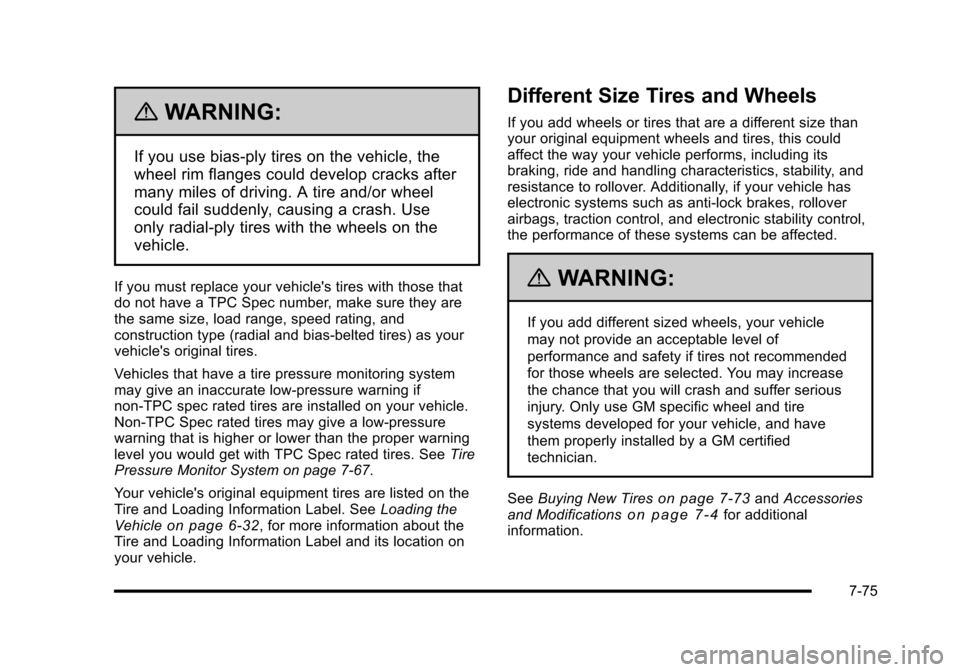
{WARNING:
If you use bias-ply tires on the vehicle, the
wheel rim flanges could develop cracks after
many miles of driving. A tire and/or wheel
could fail suddenly, causing a crash. Use
only radial-ply tires with the wheels on the
vehicle.
If you must replace your vehicle's tires with those thatdo not have a TPC Spec number, make sure they arethe same size, load range, speed rating, andconstruction type (radial and bias!belted tires) as yourvehicle's original tires.
Vehicles that have a tire pressure monitoring systemmay give an inaccurate low!pressure warning ifnon!TPC spec rated tires are installed on your vehicle.Non!TPC Spec rated tires may give a low!pressurewarning that is higher or lower than the proper warninglevel you would get with TPC Spec rated tires. SeeTirePressure Monitor System on page 7!67.
Your vehicle's original equipment tires are listed on theTire and Loading Information Label. SeeLoading theVehicleon page 6!32, for more information about theTire and Loading Information Label and its location onyour vehicle.
Different Size Tires and Wheels
If you add wheels or tires that are a different size thanyour original equipment wheels and tires, this couldaffect the way your vehicle performs, including itsbraking, ride and handling characteristics, stability, andresistance to rollover. Additionally, if your vehicle haselectronic systems such as anti!lock brakes, rolloverairbags, traction control, and electronic stability control,the performance of these systems can be affected.
{WARNING:
If you add different sized wheels, your vehicle
may not provide an acceptable level of
performance and safety if tires not recommended
for those wheels are selected. You may increase
the chance that you will crash and suffer serious
injury. Only use GM specific wheel and tire
systems developed for your vehicle, and have
them properly installed by a GM certified
technician.
SeeBuying New Tireson page 7!73andAccessoriesand Modificationso n p a g e 7!4for additionalinformation.
7-75
Page 522 of 616
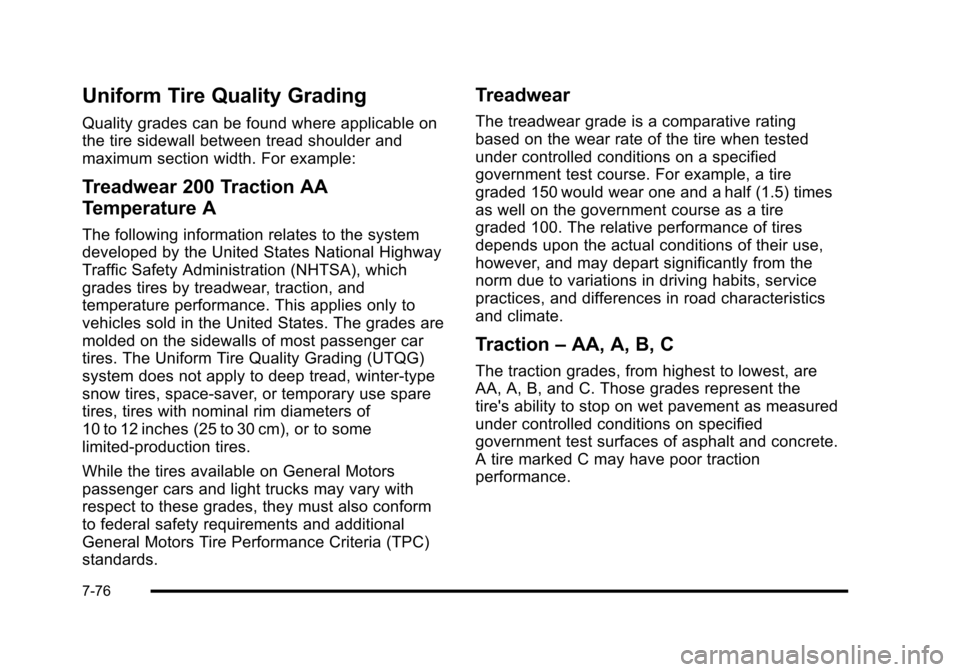
Uniform Tire Quality Grading
Quality grades can be found where applicable on
the tire sidewall between tread shoulder and
maximum section width. For example:
Treadwear 200 Traction AA
Temperature A
The following information relates to the system
developed by the United States National Highway
Traffic Safety Administration (NHTSA), which
grades tires by treadwear, traction, and
temperature performance. This applies only to
vehicles sold in the United States. The grades are
molded on the sidewalls of most passenger car
tires. The Uniform Tire Quality Grading (UTQG)
system does not apply to deep tread, winter-type
snow tires, space-saver, or temporary use spare
tires, tires with nominal rim diameters of
10 to 12 inches (25 to 30 cm), or to some
limited-production tires.
While the tires available on General Motors
passenger cars and light trucks may vary with
respect to these grades, they must also conform
to federal safety requirements and additional
General Motors Tire Performance Criteria (TPC)
standards.
Treadwear
The treadwear grade is a comparative rating
based on the wear rate of the tire when tested
under controlled conditions on a specified
government test course. For example, a tire
graded 150 would wear one and a half (1.5) times
as well on the government course as a tire
graded 100. The relative performance of tires
depends upon the actual conditions of their use,
however, and may depart significantly from the
norm due to variations in driving habits, service
practices, and differences in road characteristics
and climate.
Traction–AA, A, B, C
The traction grades, from highest to lowest, are
AA, A, B, and C. Those grades represent the
tire's ability to stop on wet pavement as measured
under controlled conditions on specified
government test surfaces of asphalt and concrete.
A tire marked C may have poor traction
performance.
7-76
Page 524 of 616
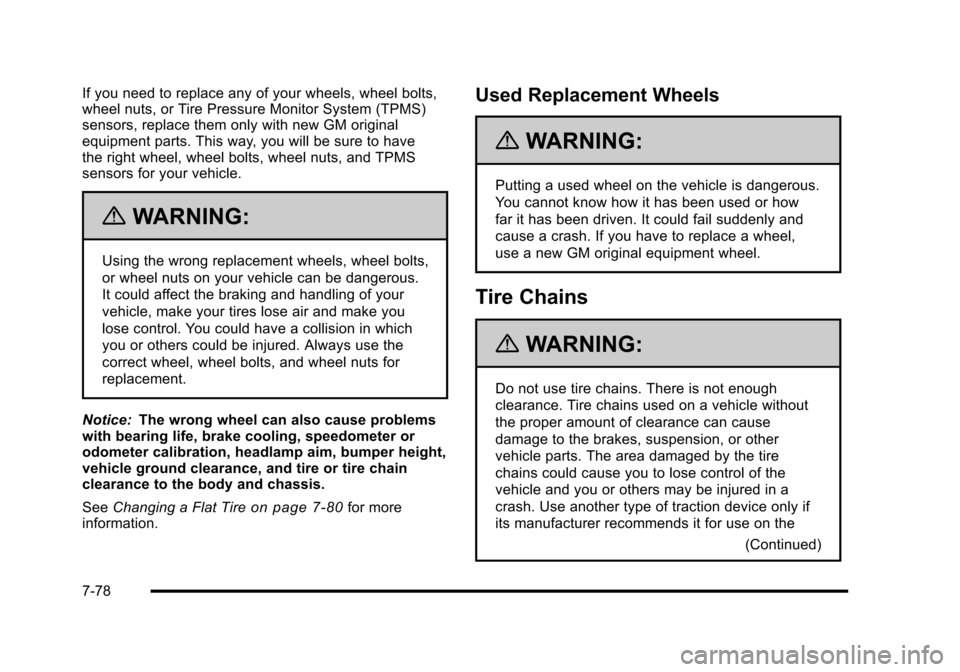
If you need to replace any of your wheels, wheel bolts,wheel nuts, or Tire Pressure Monitor System (TPMS)sensors, replace them only with new GM originalequipment parts. This way, you will be sure to havethe right wheel, wheel bolts, wheel nuts, and TPMSsensors for your vehicle.
{WARNING:
Using the wrong replacement wheels, wheel bolts,
or wheel nuts on your vehicle can be dangerous.
It could affect the braking and handling of your
vehicle, make your tires lose air and make you
lose control. You could have a collision in which
you or others could be injured. Always use the
correct wheel, wheel bolts, and wheel nuts for
replacement.
Notice:The wrong wheel can also cause problemswith bearing life, brake cooling, speedometer orodometer calibration, headlamp aim, bumper height,vehicle ground clearance, and tire or tire chainclearance to the body and chassis.
SeeChanging a Flat Tireon page 7!80for moreinformation.
Used Replacement Wheels
{WARNING:
Putting a used wheel on the vehicle is dangerous.
You cannot know how it has been used or how
far it has been driven. It could fail suddenly and
cause a crash. If you have to replace a wheel,
use a new GM original equipment wheel.
Tire Chains
{WARNING:
Do not use tire chains. There is not enough
clearance. Tire chains used on a vehicle without
the proper amount of clearance can cause
damage to the brakes, suspension, or other
vehicle parts. The area damaged by the tire
chains could cause you to lose control of the
vehicle and you or others may be injured in a
crash. Use another type of traction device only if
its manufacturer recommends it for use on the
(Continued)
7-78